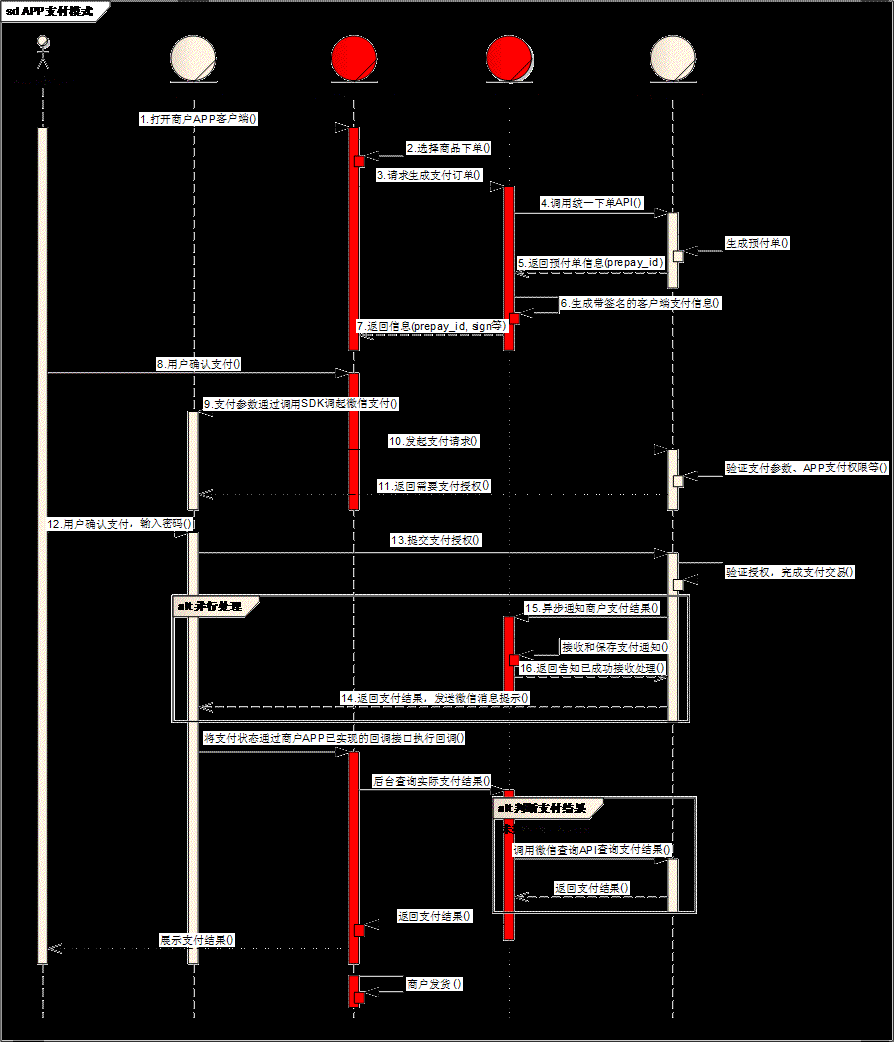开发流程
首先,看一下微信开方平台关于支付的一个时序图,如下:

微信支付时序图
https://pay.weixin.qq.com/wiki/doc/api/app/app.php
商户系统和微信支付系统主要交互说明:
步骤1:用户在商户APP中选择商品,提交订单,选择微信支付。
步骤2:商户后台收到用户支付单,调用微信支付统一下单接口。参见【统一下单API】。
步骤3:统一下单接口返回正常的prepay_id,再按签名规范重新生成签名后,将数据传输给APP。参与签名的字段名为appId,partnerId,prepayId,nonceStr,timeStamp,package。注意:package的值格式为Sign=WXPay
步骤4:商户APP调起微信支付。api参见本章节【app端开发步骤说明】
步骤5:商户后台接收支付通知。api参见【支付结果通知API】
步骤6:商户后台查询支付结果。,api参见【查询订单API】这里我讲解的服务端的开发,那我们就看服务端需要做什么工作。
第一步 统一下单
商户系统先调用该接口在微信支付服务后台生成预支付交易单,返回正确的预支付交易回话标识后再在APP里面调起支付。
首先,准备请求的参数
代码如下:
private SortedMap<String, Object> prepareOrder(String ip, String orderId,
int price) {
Map<String, Object> oparams = ImmutableMap.<String, Object> builder()
.put("appid", ConfigUtil.APPID)//应用号
.put("body", WeixinConstant.PRODUCT_BODY)// 商品描述
.put("mch_id", ConfigUtil.MCH_ID)// 商户号
.put("nonce_str", PayCommonUtil.CreateNoncestr())// 16随机字符串(大小写字母加数字)
.put("out_trade_no", orderId)// 商户订单号
.put("total_fee", "1")// 银行币种支付的钱钱啦
.put("spbill_create_ip", ip)// IP地址
.put("notify_url", ConfigUtil.NOTIFY_URL) // 微信回调地址
.put("trade_type", ConfigUtil.TRADE_TYPE)// 支付类型 APP
.build();
return MapUtils.sortMap(oparams);
}接下来将这些请求参数格式化成XML格式的数据 like this
<xml>
<appid>wx2421b1c4370ec43b</appid>
<attach>支付测试</attach>
<body>APP支付测试</body>
<mch_id>10000100</mch_id>
<nonce_str>1add1a30ac87aa2db72f57a2375d8fec</nonce_str>
<notify_url>http://wxpay.weixin.qq.com/pub_v2/pay/notify.v2.php</notify_url>
<out_trade_no>1415659990</out_trade_no>
<spbill_create_ip>14.23.150.211</spbill_create_ip>
<total_fee>1</total_fee>
<trade_type>APP</trade_type>
<sign>0CB01533B8C1EF103065174F50BCA001</sign>
</xml>请求统一下单地址 https://api.mch.weixin.qq.com/pay/unifiedorder
代码(部分代码)
String requestXML = PayCommonUtil.getRequestXml(parameters);// 生成xml格式字符串
String responseStr = HttpUtil.httpsRequest(
ConfigUtil.UNIFIED_ORDER_URL, "POST", requestXML);// 带上post完成之后将微信返回的数据进行解析,取出APP客户端需要的数据,用于唤起微信支付。
代码
/**
* 生成订单完成,返回给android,ios唤起微信所需要的参数。
*
* @param resutlMap
* @return
* @throws UnsupportedEncodingException
*/
private SortedMap<String, Object> buildClientJson(
Map<String, Object> resutlMap) throws UnsupportedEncodingException {
// 获取微信返回的签名
/**
* backObject.put("appid", appid);
*
* backObject.put("noncestr", payParams.get("noncestr"));
*
* backObject.put("package", "Sign=WXPay");
*
* backObject.put("partnerid", payParams.get("partnerid"));
*
* backObject.put("prepayid", payParams.get("prepayid"));
*
* backObject.put("appkey", this.appkey);
*
* backObject.put("timestamp",payParams.get("timestamp"));
*
* backObject.put("sign",payParams.get("sign"));
*/
Map<String, Object> params = ImmutableMap.<String, Object> builder()
.put("appid", ConfigUtil.APPID)
.put("noncestr", PayCommonUtil.CreateNoncestr())
.put("package", "Sign=WXPay")
.put("partnerid", ConfigUtil.MCH_ID)
.put("prepayid", resutlMap.get("prepay_id"))
.put("timestamp", DateUtils.getTimeStamp()).build();//取10位时间戳
// key ASCII排序
SortedMap<String, Object> sortMap = MapUtils.sortMap(params);
sortMap.put("package", "Sign=WXPay");
// paySign的生成规则和Sign的生成规则同理
String paySign = PayCommonUtil.createSign("UTF-8", sortMap);
sortMap.put("sign", paySign);
return sortMap;
}整个统一下订单的逻辑就完成了。这里小结一下:
-
请求参数需要按照参数的key进行字母的ASCII码进行排序,由于我使用的是map数据结构,这里提供一个对map集合中的key元素进行排序的工具类
/**
* 对map根据key进行排序 ASCII 顺序
*
* @param 无序的map
* @return
*/
public static SortedMap<String, Object> sortMap(Map<String, Object> map) {
List<Map.Entry<String, Object>> infoIds = new ArrayList<Map.Entry<String, Object>>(
map.entrySet());
// 排序
Collections.sort(infoIds, new Comparator<Map.Entry<String, Object>>() {
public int compare(Map.Entry<String, Object> o1,
Map.Entry<String, Object> o2) {
return (o1.getKey()).toString().compareTo(o2.getKey());
}
});
SortedMap<String, Object> sortmap = new TreeMap<String, Object>();
for (int i = 0; i < infoIds.size(); i++) {
String[] split = infoIds.get(i).toString().split("=");
sortmap.put(split[0], split[1]);
}
return sortmap;
}-
对排序后的数据进行MD5签名,微信服务端会进行校验,防止数据在网络传输过程中被篡改。
-
拿到微信响应的数据,首先要做的事,也是对获取的数据进行签名校验,理由同上。
-
需要注意的一点,返回给app客户端的数据的key一定是小写,这点微信的api是没有说明白的,之前和客户端联调时耽误了很多时间,这也是微信支付被很多开发者吐槽的地方
api比较难用^-^ -
注意小细节:返回给客户端时时间戳要是10位的,太长ios那边会越界,支付不成功。
第二步 调起支付
支付成功后,微信就会调用你填写的notify_url的方法,本人微信支付的开发配置中说明了我的notify_url为http://ip:port/weixin
/pay/callback/pay.action
对后台通知交互时,如果微信收到商户的应答不是成功或超时,微信认为通知失败,微信会通过一定的策略(如 30 分钟共 8 次)定期重新发起通知,尽可能提高通知的成功率,但微信不保证通知最终能成功。由于存在重新収送后台通知的情况,因此同样的通知可能会多次収送给商户系统。 商户系统必须能够正确处理重复的通知。推荐的做法是,当收到通知进行处理时,首先检查对应业务数据的状态,判断该通知是否已经处理过,如果没有处理过再进行处理,如果处理过直接返回结果成功。在对业务数据进行状态检查和处理之前,要采用数据锁进行幵収控制,以避免凼数重入造成的数据混乱。判断完成后,我们需要通知微信,我们收到信息了,不然微信就会通过一定的策略定期重新发起通知。
/**
* 微信回调告诉微信支付结果 注意:同样的通知可能会多次发送给此接口,注意处理重复的通知。
* 对于支付结果通知的内容做签名验证,防止数据泄漏导致出现“假通知”,造成资金损失。
*
* @param params
* @return
*/
public String callback(HttpRequest request) {
try {
String responseStr = parseWeixinCallback(request);
Map<String, Object> map = XMLUtil.doXMLParse(responseStr);
// 校验签名 防止数据泄漏导致出现“假通知”,造成资金损失
if (!PayCommonUtil.checkIsSignValidFromResponseString(responseStr)) {
logger.error("微信回调失败,签名可能被篡改");
return PayCommonUtil.setXML("FAIL", "invalid sign");
}
if (WeixinConstant.FAIL.equalsIgnoreCase(map.get("result_code")
.toString())) {
logger.error("微信回调失败");
return PayCommonUtil.setXML("FAIL", "weixin pay fail");
}
if (WeixinConstant.SUCCESS.equalsIgnoreCase(map.get("result_code")
.toString())) {
//获取应用服务器需要的数据进行持久化操作
String outTradeNo = (String) map.get("out_trade_no");
String transactionId = (String) map.get("transaction_id");
String totlaFee = (String) map.get("total_fee");
Integer totalPrice = Integer.valueOf(totlaFee);
if (PayApp.theApp.isDebug()) {// 测试时候支付一分钱,买入价值6块的20分钟语音
totalPrice = 6;
}
boolean isOk = updateDB(outTradeNo, transactionId, totalPrice,
2);
// 告诉微信服务器,我收到信息了,不要在调用回调action了
if (isOk) {
return PayCommonUtil.setXML(WeixinConstant.SUCCESS, "OK");
} else {
return PayCommonUtil
.setXML(WeixinConstant.FAIL, "pay fail");
}
}
} catch (Exception e) {
logger.debug("支付失败" + e.getMessage());
return PayCommonUtil.setXML(WeixinConstant.FAIL,
"weixin pay server exception");
}
return PayCommonUtil.setXML(WeixinConstant.FAIL, "weixin pay fail");
}小结:
-
当在本地做开发时,微信回调是不方便的,这里提供一种比较快速的方法,不过前提是有云服务器。用ssh建立反向通道。
步骤如下:
(1) ssh -R 9999:localhost:9000 ubuntu@myserver_ip_address,输入密码;
(2) server上查看一下是否监听了9999端口,netstat -anltp | grep 9999;
ubuntu@VM-39-45-ubuntu:~$ netstat -anltp | grep 9999
(Not all processes could be identified, non-owned process info
will not be shown, you would have to be root to see it all.)
tcp 0 0 127.0.0.1:9999 0.0.0.0:* LISTEN -
tcp6 0 0 ::1:9999 :::* LISTEN -
(3) 在本地9000上开启web服务;
(4) 当微信回调公网服务器时就会被代理到本地9000端口对应的web服务;这样就可以在本地调试了,是不是很方便呢。
2.回调逻辑中记得,将重要数据在应用服务器进行持久化哦。
第三步 查询订单
该接口提供所有微信支付订单的查询,商户可以通过该接口主动查询订单状态,完成下一步的业务逻辑。
需要调用查询接口的情况:
◆ 当商户后台、网络、服务器等出现异常,商户系统最终未接收到支付通知;
◆ 调用支付接口后,返回系统错误或未知交易状态情况;
◆ 调用被扫支付API,返回USERPAYING的状态;
◆ 调用关单或撤销接口API之前,需确认支付状态;需要提供两个参数
outTradeNo 商户订单号
transactionId 微信订单号
二选一
请求接口 https://api.mch.weixin.qq.com/pay/orderquery
代码:
/**
* 封装查询请求数据
* @param outTradeNo
* @param transactionId
* @return
*/
private SortedMap<String, Object> prepareQueryData(String outTradeNo,
String transactionId) {
Map<String, Object> queryParams = null;
// 微信的订单号,优先使用
if (null == outTradeNo || outTradeNo.length() == 0) {
queryParams = ImmutableMap.<String, Object> builder()
.put("appid", ConfigUtil.APPID)
.put("mch_id", ConfigUtil.MCH_ID)
.put("transaction_id", transactionId)
.put("nonce_str", PayCommonUtil.CreateNoncestr()).build();
} else {
queryParams = ImmutableMap.<String, Object> builder()
.put("appid", ConfigUtil.APPID)
.put("mch_id", ConfigUtil.MCH_ID)
.put("out_trade_no", outTradeNo)
.put("nonce_str", PayCommonUtil.CreateNoncestr()).build();
}
// key ASCII 排序
SortedMap<String, Object> sortMap = MapUtils.sortMap(queryParams);
// 签名
String createSign = PayCommonUtil.createSign("UTF-8", sortMap);
sortMap.put("sign", createSign);
return sortMap;
}下一步对微信响应的数据进行解析,检查支付的状态
代码如下
/**
* 查询订单状态
*
* @param params
* 订单查询参数
* @return
*/
public HttpResult<String> checkOrderStatus(SortedMap<String, Object> params) {
if (params == null) {
return HttpResult.error(1, "查询订单参数不能为空");
}
try {
String requestXML = PayCommonUtil.getRequestXml(params);// 生成xml格式字符串
String responseStr = HttpUtil.httpsRequest(
ConfigUtil.CHECK_ORDER_URL, "POST", requestXML);// 带上post
SortedMap<String, Object> responseMap = XMLUtil
.doXMLParse(responseStr);// 解析响应xml格式字符串
// 校验响应结果return_code
if (WeixinConstant.FAIL.equalsIgnoreCase(responseMap.get(
"return_code").toString())) {
return HttpResult.error(1, responseMap.get("return_msg")
.toString());
}
// 校验业务结果result_code
if (WeixinConstant.FAIL.equalsIgnoreCase(responseMap.get(
"result_code").toString())) {
return HttpResult.error(2, responseMap.get("err_code")
.toString() + "=" + responseMap.get("err_code_des"));
}
// 校验签名
if (!PayCommonUtil.checkIsSignValidFromResponseString(responseStr)) {
logger.error("订单查询失败,签名可能被篡改");
return HttpResult.error(3, "签名错误");
}
// 判断支付状态
String tradeState = responseMap.get("trade_state").toString();
if (tradeState != null && tradeState.equals("SUCCESS")) {
return HttpResult.success(0, "订单支付成功");
} else if (tradeState == null) {
return HttpResult.error(4, "获取订单状态失败");
} else if (tradeState.equals("REFUND")) {
return HttpResult.error(5, "转入退款");
} else if (tradeState.equals("NOTPAY")) {
return HttpResult.error(6, "未支付");
} else if (tradeState.equals("CLOSED")) {
return HttpResult.error(7, "已关闭");
} else if (tradeState.equals("REVOKED")) {
return HttpResult.error(8, "已撤销(刷卡支付");
} else if (tradeState.equals("USERPAYING")) {
return HttpResult.error(9, "用户支付中");
} else if (tradeState.equals("PAYERROR")) {
return HttpResult.error(10, "支付失败");
} else {
return HttpResult.error(11, "未知的失败状态");
}
} catch (Exception e) {
logger.error("订单查询失败,查询参数 = {}", JSONObject.toJSONString(params));
return HttpResult.success(1, "订单查询失败");
}
}